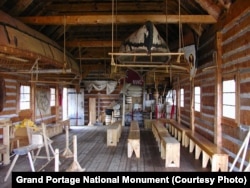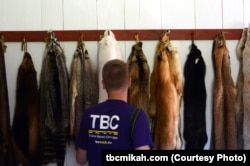This past June, 30-year-old Mikah Meyer set out from Washington, DC on a roadtrip across America to visit more than 400 sites within the U.S. National Park system. And VOA has been following him as he travels from state to state.
Thanks to the stunning photographs and videos Mikah and his travel companion Andy Waldron have been sending us, we have a virtual front row seat to some of the most amazing land and waterscapes within the U.S. national park system. As one observer recently noted, it’s almost as good as being there.
Remembering the past to discover the present
Grand Portage National Monument sits along the coastline of Lake Superior in the northeastern corner of Minnesota near the border to Canada.
The park was created to preserve the rich history of the area, once the center of a thriving fur trade, and home -- then and now -- to the indigenous Ojibwe tribe.
At the park's bustling partially-reconstructed fur trade depot, Mikah visited a Native American encampment exhibit.
He was also able to check out a fine collection of birchbark canoes, which were the primary mode of water transportation among Native Americans, and the principal means for shipping pelts to market during the fur trade among both the natives and the Europeans.
Birchbark canoes were resilient and waterproof; qualities that made them an ideal vessel for transporting goods, Mikah remarked.
The perfect partnership
The curious adventurer also got to see -- and touch -- examples of animal pelts that were common during the fur trade.
It was fascinating to feel the different textures, Mikah said. And in learning about the area’s history, he commented on how impressed he was by how people from different cultures were able to work together for a common goal.
“The French, the British and the Native Americans all worked together to create this economy,” he said, adding, “This is one of the few stories I've ever heard of Native Americans interacting with the Western Europeans that isn't a tragedy."
The fur trade in North America lasted from the 17th into the 19th century. And while demand for fur in the United States has steadily decreased over the years, it is still a viable trade in other parts of the world.
“The Grand Portage National Monument isn’t that big,” said Mikah. “It doesn't take that long to walk around, but the area itself, the bay and the history of the Native Americans and how they used that bay,” he says, “really adds to the experience.”
Heart of the Continent
Mikah spent the last days of July in Minnesota's Voyageurs National Park, a giant peninsula that reaches into Lake Superior. Here, he was able to touch rocks “half as old as the world,” immerse himself in the sights and sounds of a boreal forest and ply some of the interconnected water routes.
Mikah was struck by the lack of development in the park. “So you can go out to this peninsula and there are over 200 islands over one-acre each in size and they have no houses on them, there are no hotels,” he said.
“This is raw, natural nature as it would have been hundreds of thousands of years ago, as evidenced by the over 50 pairs of nesting bald eagles,” he said.
Pure water wilderness
“Voyageurs National Park is a good example of what Minnesota would have looked like hundreds of years ago before man messed with it,” said Mikah. It was a great opportunity to “really experience the pristine water wilderness in the state of Minnesota and a representative of one of America's gorgeous lakes.”
In a 2002 study of Voyageurs' fur trade sites and artifacts, archaeologist and historian Douglas A. Birk called this park “a place of rare natural beauty, celebrated for its associations with North American Indians and fur traders.”
Coming attractions
As August begins, Mikah and Andy are starting their drive across the state of North Dakota, where they plan to visit three national parks.
To follow Mikah and learn more about the places he’s traveling to, he invites you to visit him on his website.












